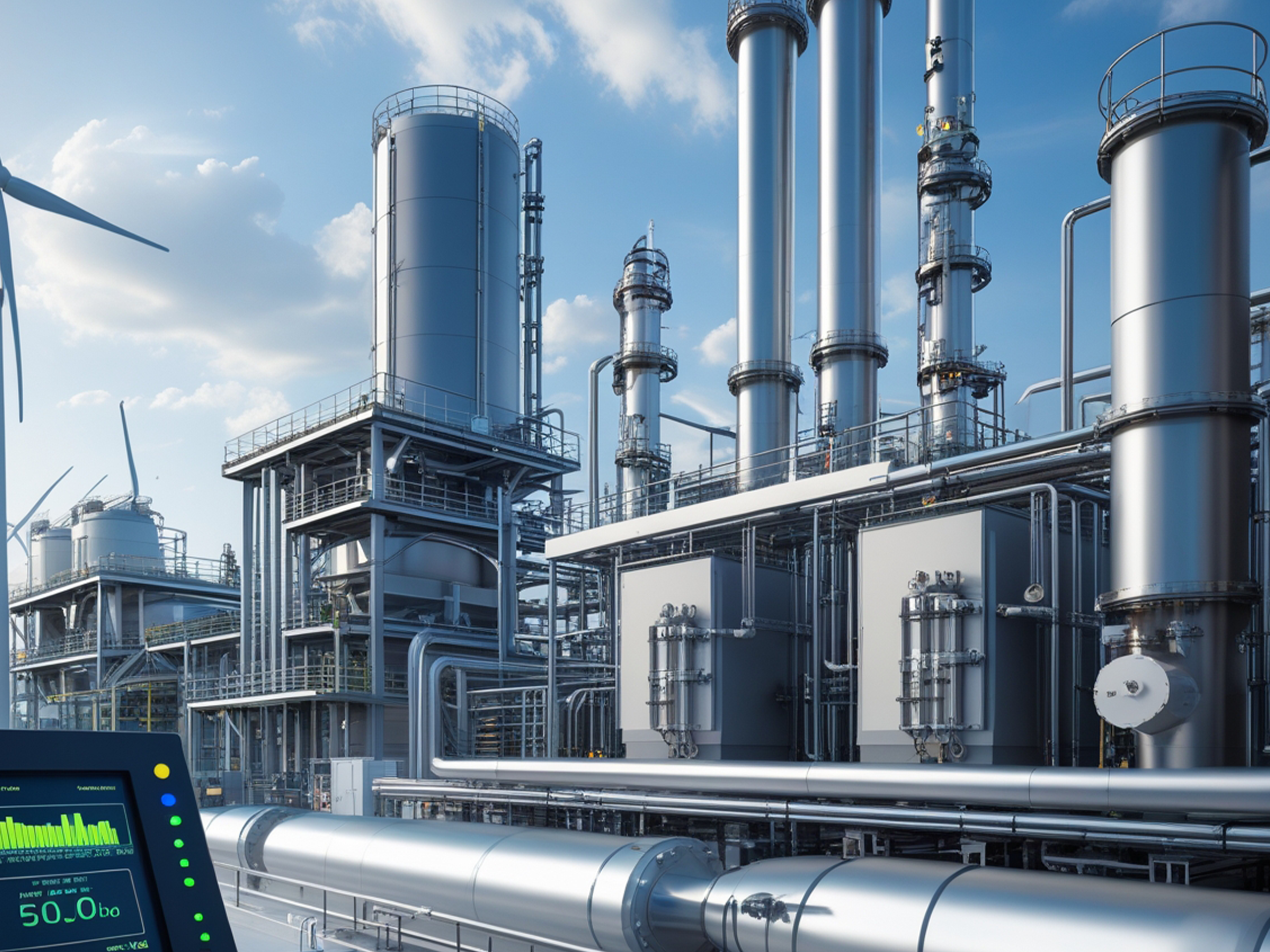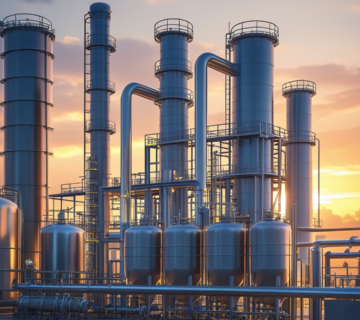Introduction
1. The Carbon Footprint of Urea Production
Urea production is inherently tied to carbon emissions, primarily due to its reliance on the Haber-Bosch process and subsequent reactions that involve carbon dioxide (CO₂). In traditional manufacturing facilities, ammonia is produced by combining nitrogen (N₂) and hydrogen (H₂) under high temperatures (400–500°C) and pressures (150–200 atm). While this process is efficient at generating ammonia, it also emits large quantities of CO₂, particularly from the reforming of natural gas (methane) used to obtain hydrogen.
Once ammonia is produced, the next step in urea synthesis involves reacting it with CO₂. While some of this CO₂ is integrated into the final product—urea itself—excess CO₂ is often vented into the atmosphere. This surplus emission significantly contributes to the carbon footprint of urea production, making it a major source of greenhouse gases within the nitrogen fertilizer industry.
In addition to the direct emissions, indirect emissions also play a role. The energy-intensive nature of the process means that unless renewable or low-carbon energy sources are used, the production of the required heat and pressure can add to the overall carbon footprint. Conventional facilities running on fossil fuels further compound the issue.
The environmental impact of these emissions is far-reaching. Not only does it contribute to global warming, but it also poses challenges for compliance with increasingly stringent climate regulations. Governments and environmental bodies around the world are pressing industries to adopt cleaner technologies, reduce emissions, and move toward sustainable production methods.
By integrating carbon capture and storage (CCS) technologies, the urea production industry can mitigate these emissions. CCS systems capture CO₂ at its source, preventing its release into the atmosphere and instead utilizing it directly in the urea production cycle. This approach not only reduces the carbon footprint but also aligns the industry with global sustainability goals. For more insights on reducing urea’s carbon footprint, visit Riyoniz Urea Chemistry.
2. How Carbon Capture Enhances Production
Carbon capture technologies are reshaping the urea production process by significantly improving both environmental sustainability and operational efficiency. By capturing and utilizing CO₂ at the source, these systems help urea producers optimize their chemical processes while reducing greenhouse gas emissions.
Integration into Urea Synthesis
The urea manufacturing process inherently requires carbon dioxide as a key feedstock. In traditional setups, CO₂ is generated as a by-product of ammonia production, a stage that involves reforming natural gas to produce hydrogen. Historically, this CO₂ was vented into the atmosphere. Carbon capture systems, however, intercept the CO₂ before it can escape, ensuring a steady, high-quality supply for urea synthesis. This creates a circular system where CO₂ emissions are reused rather than released, improving overall process efficiency.
Increased Process Stability and Quality
By maintaining a constant, controlled flow of captured CO₂, producers can achieve:
Better Reaction Consistency: Reliable CO₂ levels help stabilize the reaction with ammonia, resulting in consistent product quality.
Reduced Variability: Fluctuations in CO₂ availability can lead to production inconsistencies. Captured CO₂ ensures a uniform feedstock, minimizing production downtimes and enhancing overall yield.
Lower Raw Material Costs: With a direct source of CO₂ from the capture process, producers rely less on external CO₂ supplies, cutting costs and reducing supply chain complexities.
Environmental and Economic Benefits
In addition to improving the production process, carbon capture technologies align urea production facilities with stricter environmental standards. By using CO₂ that would otherwise be emitted, plants lower their overall carbon footprint, enhancing their environmental credentials. This not only meets regulatory requirements but also provides an economic incentive, as facilities that adopt carbon capture may benefit from tax credits, carbon offset programs, and a stronger market position.
3. Environmental Benefits of Carbon Capture
Carbon capture technologies offer significant environmental advantages for the traditionally carbon-intensive urea production industry. By integrating these systems, producers can drastically reduce greenhouse gas emissions and mitigate the industry’s impact on climate change.
Reducing CO₂ Emissions at the Source
In conventional urea production, large amounts of CO₂ are emitted during the ammonia synthesis stage. Carbon capture systems intercept this CO₂ before it can enter the atmosphere, converting it into a valuable feedstock for urea synthesis. By preventing these emissions, facilities can reduce their carbon footprint by up to 90% depending on the capture system and process conditions. This not only slows the progression of climate change but also aligns with global efforts to lower industrial emissions.
Supporting Sustainable Agriculture
As the majority of urea produced globally is used in fertilizers, cleaner production directly benefits agriculture. Lower-emission urea contributes to more sustainable farming practices, helping reduce the overall environmental impact of food production. With less CO₂ released, farmers and producers can meet eco-certification standards, appeal to environmentally conscious markets, and maintain soil fertility without contributing heavily to atmospheric carbon.
Driving Innovation and Climate Solutions
The implementation of carbon capture systems sets a precedent for broader adoption of clean technologies across the chemical and fertilizer industries. By demonstrating how CO₂ can be effectively captured and reused, urea producers help pave the way for other sectors to follow suit, creating a ripple effect that extends well beyond their own operations.
For more details on the environmental advantages of CCS, visit Riyoniz Urea Chemistry.
4. Economic Advantages of CCS in Urea Production
Beyond its environmental benefits, carbon capture and storage (CCS) offers substantial economic advantages for urea production facilities. Implementing CCS not only aligns with global climate regulations but also enhances long-term financial stability by improving efficiency, reducing waste, and opening new revenue streams.
1. Cost Savings through Resource Efficiency
Internal CO₂ Utilization:
Captured CO₂ can be reused directly in urea synthesis, reducing reliance on external suppliers. This leads to lower raw material costs and more predictable operating expenses.Energy Optimization:
Many modern CCS systems incorporate energy recovery features, improving overall plant efficiency. By reducing energy wastage, facilities can lower production costs per ton of urea.
2. Compliance and Incentives
Regulatory Advantages:
Meeting stricter emissions standards prevents costly fines and helps maintain operational licenses.Carbon Credits and Subsidies:
Facilities that adopt CCS often qualify for government incentives, tax breaks, and carbon offset credits. These financial benefits help offset the initial investment in CCS technology.
3. Competitive Market Position
Eco-Conscious Consumer Appeal:
As demand grows for sustainable products, facilities that produce lower-carbon urea can command a premium price.Long-Term Market Sustainability:
By adopting CCS early, producers position themselves ahead of competitors, ensuring a strong foothold in future low-carbon economies.
Incorporating CCS not only secures compliance and efficiency gains but also drives profitability and long-term resilience for urea manufacturers. Learn more about our urea production solutions.
5. The Future of Urea Production with CCS
As the global focus on sustainability intensifies, carbon capture and storage (CCS) technologies are set to play a central role in shaping the future of urea production. These systems are no longer viewed as optional upgrades; rather, they are becoming essential components for facilities seeking to remain competitive, compliant, and environmentally responsible in a rapidly changing industrial landscape.
1. Integration with Renewable Energy Sources
One key trend is the integration of CCS with renewable hydrogen production, such as hydrogen derived from water electrolysis powered by solar or wind energy. By combining these technologies, urea producers can drastically reduce their reliance on natural gas, thereby cutting emissions at every stage of the production process. This fusion of CCS and renewables holds the potential to create a fully carbon-neutral urea production model, setting a new standard for the industry.
2. Evolving Regulations and Global Climate Targets
Stricter climate policies and ambitious global emission reduction goals are pushing producers to adopt CCS at scale. Facilities that invest in carbon capture today will not only meet current regulations but also position themselves to exceed future standards. This proactivity ensures long-term operational viability and protects producers from potential penalties or market exclusion.
3. Driving Innovation and Economic Benefits
Continued investment in CCS innovation—such as more efficient capture methods, improved catalysts, and enhanced storage solutions—will lower costs and make the technology accessible to a wider range of facilities. Over time, these advancements will help the entire industry transition to cleaner, more efficient production methods, securing a sustainable future for urea production.
For insights on sustainable urea production, visit Riyoniz Urea Chemistry.
Conclusion
Carbon capture technologies are not just a trend—they are a transformative approach that ensures urea production aligns with the demands of a low-carbon future. By reducing emissions, improving efficiency, and integrating renewable energy sources, CCS technologies represent a sustainable pathway for growth. Facilities that adopt CCS can maintain regulatory compliance, appeal to eco-conscious markets, and drive innovation across the fertilizer and chemical industries. The combination of environmental responsibility and economic opportunity positions urea producers at the forefront of the sustainability movement, paving the way for a cleaner, greener, and more resilient global agriculture and industrial landscape. Learn more at Riyoniz Urea Chemistry.






